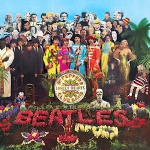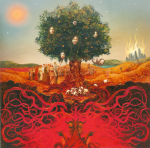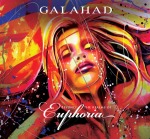Before the advent of the record album, music was written and performed to the length seen as appropriate by the composer or in some cases by the performer. Particularly in classical music, the symphony and the suite were long and complex compositions that were comprised of movements. When Jon Anderson and Steve Howe of Yes began work on “Close to the Edge”, they approached the song as a suite with four movements. The resulting album with its 18-minute plus title track raced to the top five in both Britain and the U.S.A. Inspired by their success, the next album “Tales from Topographic Oceans” was a double-disc release with just four songs, each one occupying the entire side of a disc. So as not to bury themselves in repetition, each song featured a different approach to composition, thus avoiding an album of four “Close to the Edges”. However, the task of making each song stretch to the 20-minute mark sometimes forced the band to come up with ideas to throw in. As such, there are mixed opinions about the music with some people claiming most of the songs fail to be as concise as “Close to the Edge” and could have been better were they shorter. For the following album, Yes returned to the formula of “Close to the Edge”, writing one long song for side one and two 10-minute songs for side two.
To fill an entire side of an album with one song usually meant writing a piece around 20 minutes long. Bob Dylan’s “Sad-eyed Lady of the Lowlands” filled an entire side of an album but was only 11:22. UFO created the space guitar epic “Flying”, which not only cleared 26 minutes but surprisingly shared side two with another shorter track. Still, there were spatial limitations to filling one side of an album. The grooves of a vinyl disc could only be etched so close together otherwise the stylus would pick up “echoes” from the adjacent grooves. UFO had really pushed the physical limits of the disc.
It took a facetious Ian Anderson of Jethro Tull to take the next big step and create the single-song album. After hearing that Tull’s album “Aqualung” was being regarded as a concept album despite that he insisted that it wasn’t, Anderson decided to give them “the mother of all concept albums”. “Thick as a Brick” is one song divided into two parts (one for each side of the album) and runs over 43 minutes long. The different “parts” of the music run fairly smoothly together, making most of the song seem like a coherent piece telling a story rather than several unrelated pieces stitched together. There are plenty of opportunities for the individual musicians to showcase their solo talents but over all the song holds together rather well. The following album “A Passion Play” would follow the same format and actually run a little longer than “Thick as a Brick”.
Tull’s album may not necessarily have been the first album-long song. Nektar’s albums “Journey to the Centre of the Eye,” “Remember the Future,” “Down to Earth,” and “Recycled” are all concept narratives that are meant to be played from start to finish with each “part” seeming like an individual song. One could then argue whether or not Nektar’s albums are true one-song-epics. There are many side-long songs and longer that are actually individual songs that make up a narrative, as we will soon see. Jethro Tull’s “Thick as a Brick” has its parts but cannot be so neatly sliced into individual stand out songs. The transitions between parts are smooth without fading out the previous part. We won’t want to forget Mike Oldfield’s opus “Tubular Bells” that was split over two sides of an album, though part one was originally completed as a single piece before part two was requested by the record company in order to properly fill an album.
There was an alternative to writing songs that filled an entire album side or both sides, and that was writing a long song in many parts that could be split over two sides and share the album with other shorter songs.
Emerson, Lake & Palmer did that with “Karn Evil 9” from their “Brain Salad Surgery” album. It begins on side one and carries over to fill all of side two, running about 30 minutes in total. Pink Floyd still had long songs in them when they recorded “Shine on You Crazy Diamond” and split the 29-minute multi-part song over two sides, fitting in three more songs on the album.
By the mid-seventies, punk rock was rapidly gaining attention, and writing epic songs was in threat of going out of vogue. There were some late-comers such as Sweden’s Kaipa who gave us their 21:42 epic, “Skenet Bedrar”. In the U.S., Lou Reed released a double album of guitar feedback for nearly 60 minutes of noise without any normal sense of composition and direction on his fifth album, “Metal Music Machine”. But the next champions of the epic tracks were to come from a suburb of Toronto, Canada.
Starting out as a Zeppelin-esque hard rock outfit, Rush quickly began moving ahead after acquiring drummer and new lyricist, Neal Peart. Their second album, “Fly By Night” was where the journey began with “By-Tor and the Snow Dog”, an 8:39 story of good battling evil. Next came “Caress of Steel” and on side one “The Necromancer” at 12:32. But it was side two’s “The Fountain of Lamneth” that was the first side-long Rush epic, clocking in at just under 20 minutes. Grand though it was, the song plays out like a series of individual short songs that are chapters in the narrative. Listening to the track, there seems to be no reason why each part couldn’t have been a separate track as each part wraps up with a brief pause before the next part begins.
In 1976, Rush created one of their most influential epics, the futuristic story “2112”. It too followed the style of a narrative told in separate parts but here the parts seemed to stick together better. But it was what was to follow that showed the world that these three musicians from the Great White North had really gotten the hang of writing prog rock epics. “Cygnus X-1” (12:21) and “Cygnus X-1 Book II – Hemispheres” (18:08) are two well-crafted songs that appeared on “Farewell to Kings” and “Hemispheres” respectively. Each song, the shorter and the longer, have all the parts very craftily worked out so that the songs move along smoothly while changing rhythm, tempo, and melody. Although separate songs, their stories are interwoven so that what happens in the first song is related to what happens in the second song.
The long song never really died out, but it did wane in popularity in the rock world as the 80’s approached. Of course there were underground artists who still filled up one side of an album, but the glory days seemed to have died in the 70’s.
In 1984, Iron Maiden released their musical interpretation of Samuel Coolidge Taylor’s “Rhyme of the Ancient Mariner”. Much fuss was made about its length, nearly 14 minutes! But two other artists popped out a one-side epic, one in that same year and one the year prior. Extreme metal band from Britain, Venom, inspired by Rush’s “2112”, issued an album in 1984 where the entire first side was a narrative of Heaven embattled with Hell. “At War with Satan” was a surprisingly grandiose effort by a band known for three-minute bashers but many critics gave it positive reviews. The other was the neo-prog band, IQ, who managed to get their big time debut (they’d released a cassette debut earlier) “Tales from the Lush Attic” released in 1983, with its side-one-filling epic, “The Last Human Gateway”. And while not a single track, Kate Bush also included a multi-part narrative on her fourth album, “Hounds of Love”. Things were looking up.
Until this time, bands and individual artists were limited to either one side or both sides of an album. Long songs were somewhere between 17 minutes and 48 minutes. The new compact disc format was going to shake things up for with a CD it became possible to record songs of up to nearly 80 minutes long!
The long song revival coming up in part three.












